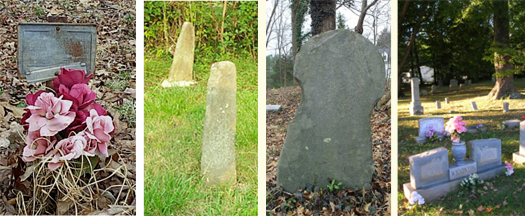- Classification
- Landscape
- Gravestone Variability
- Epitaphs and Inscriptions
- Mortuary Practices
- Other Resources
Gravestone Variability
The gravestones in African-American cemeteries range from large, granite slabs to impermanent wooden posts. This includes mass-produced markers (such as inscribed marble, small metal 'picture frames' provided by funeral homes, and soapstone "boards") and hand-carved markers (worked from soapstone, marble, and concrete). The stones include a variable amount of information, from detailed inscriptions and epitaphs to unmarked and uninscribed markers. For example, slave gravestones usually lack the name of the deceased or their date of death. This practice, which may be due, in part, to the early 19th Century laws that made it illegal to teach an enslaved individual to read and write, suggests an emphasis on group mortuary practices rather than marking the death of an individual. Accordingly, many unmarked graves are clustered into kinship groupings, rather than rows of individual markers.
Other stone types include white and pink quartz, carved river cobbles, and unusually shaped fieldstones. A portion of these “rocks” are modified into distinct shapes, indicating a folk tradition of carving. Because many stones in this category lack inscriptions and utilize locally available materials, these gravestones often go unnoticed and are occasionally removed or inadvertently destroyed by property owners. One of the goals of this project is to document these historic cemeteries so that their location becomes part of the public record.

